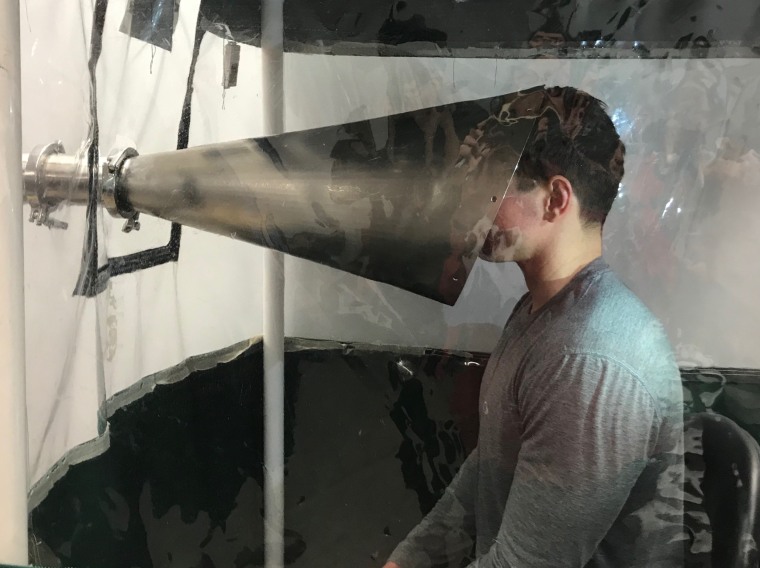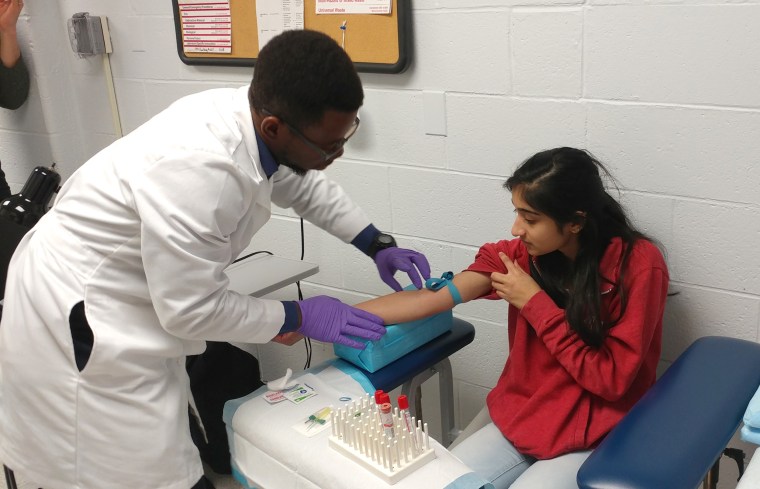Hannah Weisman is clipping Namitha Thomas’s fingernails.
This is not a beauty session. Thomas is also giving blood samples and her nose and throat will be swabbed.
It’s all part of an experiment to find out just how flu spreads. Thomas and Weisman are students at the University of Maryland, where Dr. Donald Milton and colleagues are taking a deep dive into influenza in one of its richest habitats — a college dormitory.
Thomas has been in close contact with a flu patient, and now Milton’s team will watch her and test her to see if and when she comes down with flu herself.
“Who is going to become contagious?” Milton asked.

The tests will help identify the route of transmission — whether people get infected by large droplets of mucus or saliva that carry flu virus into their nasal passages, whether they pick up the virus on their fingers from droplets that have fallen onto surfaces such as desks, or whether they breathe in the virus on tiny, airborne particles.
It’s an especially timely experiment. The U.S. is suffering through one of the most severe flu seasons in recent years. Almost every state is experiencing widespread flu activity at the same time — an unusual pattern. Understanding how and when influenza spreads can help doctors understand and, perhaps, better control the annual flu epidemic.
Signs around the campus urge students to come in if they start feeling ill to be tested for flu. If they are positive, they’re asked to give up the names of four close contacts so they can be tested for flu and followed.
Students are also asked to download an app, also designed by a student there that tracks their movements. The cellphone app can show whether they were exposed to roommates or someone in a study room.
College residence halls are perfect breeding ground for respiratory viruses such as flu.
“You’re sharing the same air in small rooms,” said Dr. Barbara Albert, head clinician helping oversee the study. “They may not even know they’ve been in contact with somebody else.”
“We are all breathing out potentially infectious viruses.”
Although influenza causes an epidemic every single year, and some years causes a more serious pandemic, how it is transmitted is poorly understood. Scientists estimate that each flu patient infects about one-and-a-half other people on average, a number known as R0 (r zero).
It's known that people can transmit influenza before they feel sick, and after they feel better, and that the virus spreads on droplets. But more subtle factors may aid the spread of flu.
Facing the sneeze machine
Milton’s lab showed earlier this year that flu virus can remain suspended in the air in tiny particles that people emit when they are breathing normally — something that many doctors had believed did not happen.
“We are all breathing out potentially infectious viruses,” said Stefanos Koutsoukos, a biochemistry major who is one of 68 students earning college credit while helping with the experiment. “It’s led me to think differently about how I may have become sick.”
They use Milton’s Gesundheit 2 machine to measure this, recruiting patients with flu to sit with their faces in the cone-shaped collection device to see what they send out with each breath.

“We are trying to figure out what students are getting sick with,” said Christine Shi, a public health major who is working on the experiment. “How much virus do the students emit?”
If someone develops flu after a close contact has had it, the tests can show how they became infected. Genetic tests can establish if student A infected student B directly.
“We can deep sequence the flu virus and see the source,” Milton said. The samples are sent to the University of Maryland’s Institute for Genome Sciences for those tests.
Which particles are worse?
A patient’s symptoms may be a function of how they caught the virus. Milton has a theory that flu causes worse symptoms if inhaled on tiny, airborne particles rather than from larger particles that are coughed or sneezed out and either breathed in or picked up from a surface.
The smaller particles, he believes, can be sucked directly down into the lungs and lower airways, making people sicker. Students' cellphones are also being swabbed.
“I think infection route matters,” Milton said.
They ask about stress, physical activity and sleep. “We are trying to get a broad picture of susceptibility,” Milton said.
The team has a grant from the Defense Advanced Research Projects Agency (DARPA) to develop various tests for infection.
“They want to know if we can identify a signal in the blood to tell us who is going to infect everybody else,” Milton said.
Last year, a few students showed up with flu but more had other viruses that cause similar symptoms, such as coronaviruses and respiratory syncytial virus or RSV. Out of 72 students tested last year, 13 had RSV-B, 10 had coronavirus OC43, 10 had adenovirus, eight had influenza A, and the rest had an assortment of coronaviruses, RSV strains, rhinovirus and another flu-like virus called human parainfluenza virus.
These are among the hundreds of viruses that cause flu-like symptoms. Understanding what spreads and how can help control epidemics that can sweep military barracks, college dorms and public schools.
Thomas, a freshman biology major from Ellicot City, Maryland who hopes to study medicine, will come back for regular checkups. “I hope you stay well,” Albert tells her as she leaves the lab.
Will she catch flu? “I really hope not,” Thomas said.

